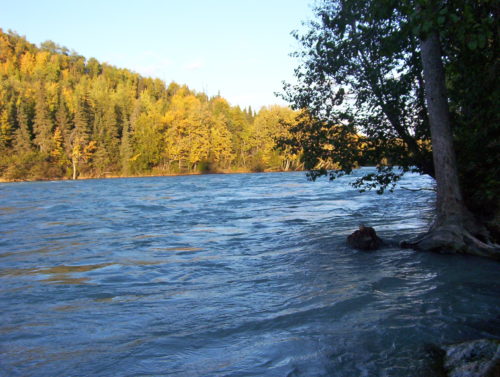Kasilof River Early-, Late-Run King Salmon Fishing Restrictions
The following press releases are courtesy of Alaska Department of Fish and Game:

Kasilof River Early-Run King Salmon Restricted to Hatchery Fish and Single-Hook Only
(Soldotna) – To protect returning king salmon and ensure fishing opportunities in the future, the Alaska Department of Fish and Game (ADF&G) is implementing the following sport fishing regulation restrictions for early-run king salmon in the Kasilof River drainage effective 12:01 a.m. Sunday, May 1 through 11:59 p.m. Thursday, June 30, 2022. The bag and possession limit for king salmon 20 inches or greater in length is two hatchery-produced fish. Hatchery-produced king salmon are recognizable by a healed adipose fin-clip scar. Naturally-produced king salmon of any size may not be possessed or retained and are distinguishable by an intact adipose fin, a small fleshy fin on the back of the fish just ahead of the tail. Naturally-produced king salmon that are caught may not be removed from the water and must be released immediately. Additionally, only one single hook may be used either baited, unbaited or on an artificial lure. Single-hook means a fishhook with only one point.
ADF&G manages the Kasilof River early-run king salmon sport fishery to achieve a sustainable escapement goal of 700-1,400 naturally-produced king salmon as monitored through an ADF&G weir located on Crooked Creek. Crooked Creek king salmon are used to supplement king salmon stocking programs across Southcentral Alaska.
“To ensure an adequate escapement and collection of broodstock of naturally-produced king salmon in 2022, ADF&G has determined restrictions to the early-run king salmon sport fishery in the Kasilof River are needed to achieve these goals,” stated Area Management Biologist Colton Lipka.
Please review these emergency order and advisory announcement in their entirety for the specific regulatory changes.
For additional information, please contact Area Management Biologist Colton Lipka or Assistant Area Management Biologist Jenny Gates at (907) 262-9368.
Kasilof River Late-Run King Salmon Fishery Starting July Limited to Hatchery Fish and No Bait
(Soldotna) – To ensure healthy returns of king salmon to Alaska’s rivers, the Alaska Department of Fish and Game (ADF&G) is implementing the following sport fishing regulation restriction on the Kasilof River effective 12:01 a.m. Friday, July 1 through 11:59 p.m. Sunday, July 31, 2022. The bag and possession limit for king salmon 20 inches or greater in length is one hatchery-produced fish. Hatchery-produced king salmon are recognizable by a healed adipose fin-clip scar. Naturally-produced king salmon of any size may not be possessed or retained and are distinguishable by an intact adipose fin, a small fleshy fin on the back of the fish just ahead of the tail. Naturally-produced king salmon that are caught may not be removed from the water and must be released immediately. Additionally, only one unbaited, single-hook, artificial lure may be used. Single-hook means a fishhook with only one point.
“King salmon runs across the Kenai Peninsula have experienced an extended period of low abundance,” stated Area Management Biologist Colton Lipka. “Regulatory restrictions have been issued for the Kenai River king salmon sport fishery during July. These restrictions will likely result in an increase in the sport fishing effort and catch of king salmon in the Kasilof River. Therefore, to minimize the effects of conservation actions for the Kenai River, it is warranted to prohibit retention of king salmon on the Kasilof River to ensure adequate escapement of Kasilof River late-run king salmon.”
In conjunction with this restriction, emergency order 2-KS-1-09-22 was issued on January 26, 2022; prohibiting the retention of king salmon while sport fishing on the Kenai River from its mouth upstream to an ADF&G regulatory marker at the outlet of Skilak Lake. In addition, only one unbaited, single-hook, artificial lure may be used when sport fishing in these waters. Please review these emergency orders and advisory announcements in their entirety for the specific regulatory changes.
For additional information, please contact Area Management Biologist Colton Lipka at (907) 262-9368.



